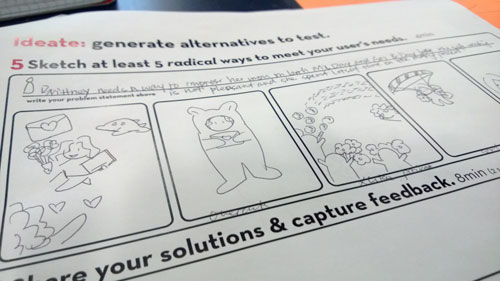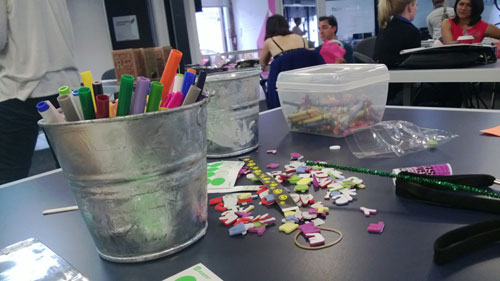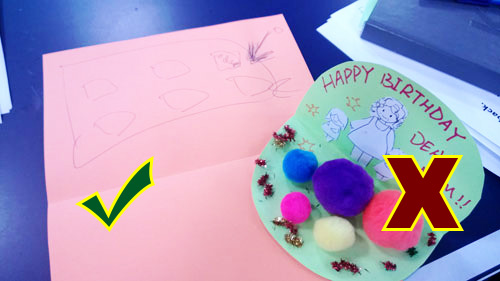
Back in 2011, I participated in a non-profit program called Technovation Challenge, to encourage high school girls to pursue further studies in engineering. That was when I came to know Design Thinking. We did some quite interesting projects using this concept, such as building phone cases and Android apps. But I wasn’t sure I could fully understand how it works until this wonderful crash course in Design Thinking.
Design thinking is a way of thinking and a problem-solving process. We can follow it to analyze context, generate creative insights and explore solutions for problems.
In this crash course, we followed these steps: empathize (when analyze the context), define (the problem), ideate (lots of solutions), prototype (the solutions) and test (the solutions and learn how to make them better). In the real world, you may repeat these steps multiple times till you find one or more solutions that fit the problem. It’s very important to learn how to improve the solutions from each cycle.
Our subject was redesigning the gift-giving experience. We paired up to start interviewing each other about the most recent experience of giving a gift to others.
My partner Brittany had a frustrating experience when preparing gifts for her mom this May. It was a great month for both Mother’s Day and her mom’s 60th birthday. Brittany crafted a lovely plan. She planned to have flowers delivered on the day of Mother’s Day, mom’s birthday and her home trip, respectively. She also planned to make a book full of great stories and memories for her mom’s birthday. But the implementation was not very smooth: the flower service online ordering process was slow; all the flowers were delivered with no blooming; and it took hours to work and rework on the book because she lost the purchase list.
Mom was very happy even though there were hiccups. But Brittany felt painful, and I was ready to revamp the experience.
I reframed and redefined the problem as: Brittany needs a way to impress her mom on both Mother’s Day and mom’s 60th Birthday, but the gift-making was not pleasant and she spent lots of time on this process.
Following this, I had 4 minutes to quickly sketch five radical ways to meet Brittany’s needs.
 Tiago, our instructor, encouraged us to find radical ways and not to worry about real-world constraints… and I came up with these ideas:
Tiago, our instructor, encouraged us to find radical ways and not to worry about real-world constraints… and I came up with these ideas:
- Meeting mom in person every time with flowers
- Showing up in a cute costume
- Calling for friends and neighbors to celebrate with mom
- Meeting mom with skydiving
- Sending mom home-made presents.
I discussed these ideas with Brittany, and we quickly found the closest solution and discarded others.
- Meeting mom in person every time with flowers (No. Her mom is in east coast while Brittany is in California with a full-time job — she cannot fly back so many times)
- Showing up in a cute costume (No. This is a cute idea but not Brittany’s style)
- Calling for friends and neighbors to celebrate with mom (No. Her mom likes to celebrate with family members and keep it private)
- Meeting mom with skydiving (This is too radical)
- Sending mom home-made presents. (This is close, because her mom loves home-made gifts.)

I was as busy and fast as a bee! Time was so tight.
“Time’s up, please introduce prototype to your partner, but do not act like a sales person.” Tiago reminded us.
 Ummmm.. something was NOT right.
Ummmm.. something was NOT right.
Brittany was staring at my prototype. “Um… I think what I need was an easier process to make home-made gifts, not another gift.”
That was correct!! According to my problem statement, I needed to find a process for her, not to make her another gift. Then, Brittany and I did some quick sketches for a website that allows user to choose materials and build a home-made gift online. What a wonderful failure and lesson!
What a wonderful failure and lesson!
I thought I built something good, but in fact it was completely off track. Fortunately, Brittany and I went back to the problem statement and got me back on track.
Have you had similar experiences like this? When I put too much focus on making something, I forgot my original purpose, what I was supposed to do. It was great that I had a partner who corrected me in this small project. What if there’s nobody to remind you when things have gone too far? You need to go back to your purpose and ensure that you’re on the right track.
I learned so much from this course, and this is probably my biggest take-away, and I have to write something about it.
Finally, a BIG THANK-YOU for my partner Brittany, and our instructor Tiago!
P.S. You can teach this course, too. Find all the materials here on the website of D.School at Stanford: 1. The Gift-Giving Project Guideline; 2. Other Design Thinking Resouces